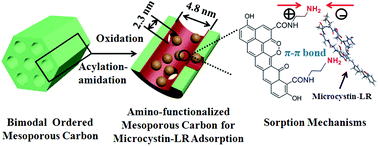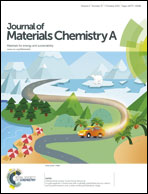Amino-functionalized ordered mesoporous carbon for the separation of toxic microcystin-LR†
Abstract
Amino-functionalized ordered mesoporous carbon materials with high surface areas are fabricated from bimodal mesoporous carbons as the matrix and functionalized with a three-step chemical modification of oxidation, acylation and amidation. Mesostructural regularity, textural evolution, properties and density of the surface functional groups are characterized. The obtained amino-functionalized mesoporous carbon possesses an ordered mesostructure, a high surface area (1063 m2 g−1), a large pore volume (0.7 cm3 g−1) and bimodal mesopores (2.3 and 4.8 nm). More importantly, the surface is positively charged under neutral pH. This type of nanomaterial is designed specially for sorption and separation of negatively charged large molecules due to the synergic advantages of positively charged amino groups, high surface area, and interconnected large mesopores. Batch and column experiments demonstrate its outstanding adsorption capability (580 and 334 mg g−1, respectively) for the removal of microcystin-LR (Mw = 995), much better than conventional activated carbon (<64 mg g−1). Properties such as porosity as well as density of the amino groups (2.73–3.84 mmol g−1) can be further fine-tuned by adjusting the oxidation procedure. Furthermore, this material can be effectively regenerated by methanol.


 Please wait while we load your content...
Please wait while we load your content...